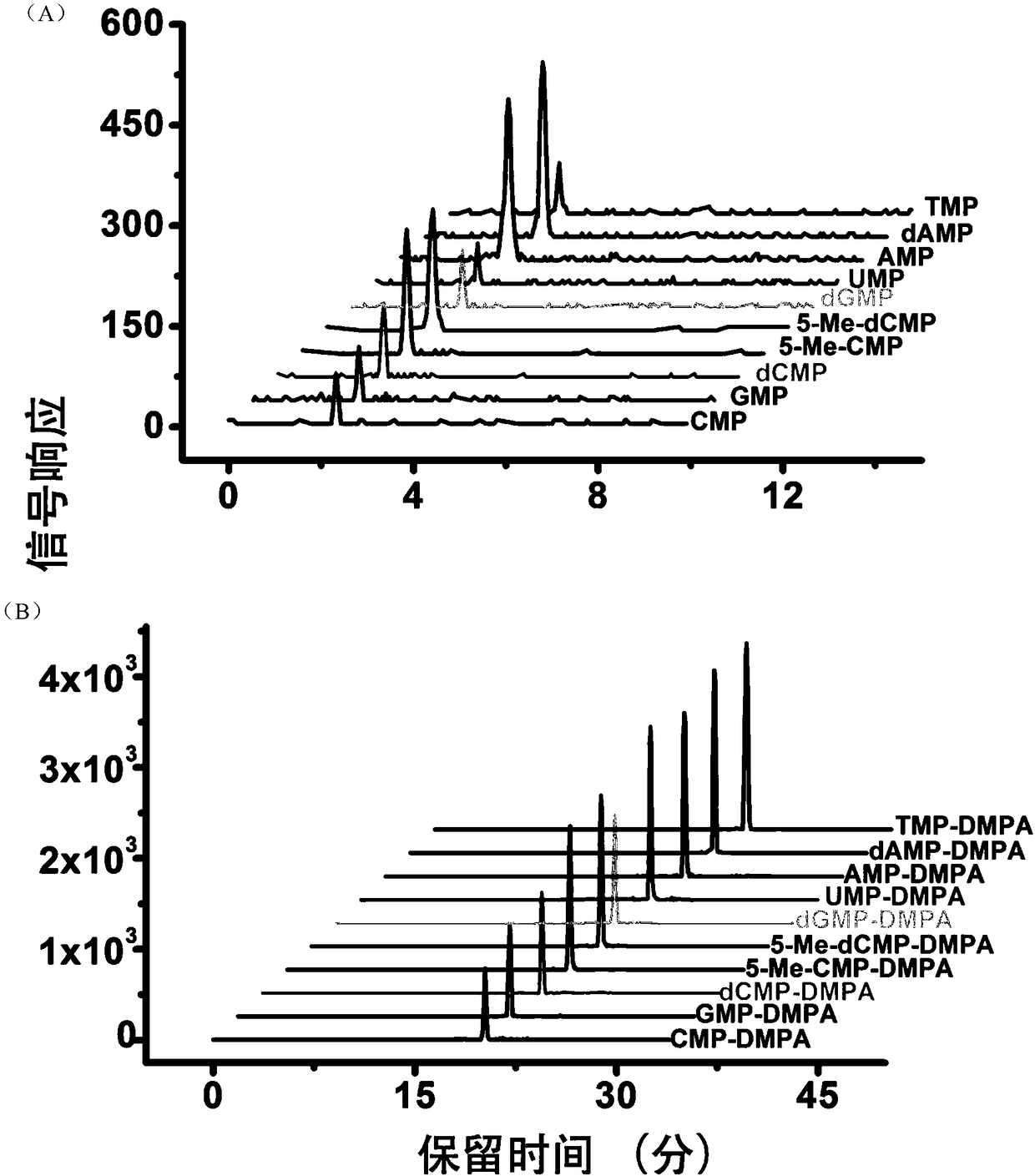A Method of Chemical Labeling Combined with LC-MS and Its Application in Nucleotide Analysis
A chemical labeling and combination technology, applied in the field of analytical chemistry, can solve the problem of limited sensitivity of nucleotides, and achieve the effect of facilitating quantitative analysis, reducing matrix interference, and avoiding contamination of mass spectrometry.
- Summary
- Abstract
- Description
- Claims
- Application Information
AI Technical Summary
Problems solved by technology
Method used
Image
Examples
Embodiment 1
[0036] 1. First prepare the working solution: (1) dissolve the labeling reagent DMPA in chromatographically pure acetonitrile to prepare a DMPA acetonitrile solution with a concentration of 1M; (2) dilute imidazole with water to prepare a solution with a concentration of 2.5mM and pH=6 Imidazole buffer solution; (3) EDC is dissolved in water, is mixed with the EDC aqueous solution that concentration is 500mM; (4) fills 200mg amino silica gel in 3mL solid-phase extraction small column; (5) the volume fraction of preparation ammonia water is 0.25%, acetonitrile Solvent S with a volume fraction of 80% and a volume fraction of pure water of 19.75%.
[0037]2. Protein removal: Take a certain amount of biological sample and put it into a 3mL homogenization tube, add methanol aqueous solution (methanol:water=4:1, v / v) pre-cooled to -80°C. Place the homogenization tube in the ice-water mixture to grind the tissue for 10 min, transfer the homogenized mixture to a 5 mL centrifuge tube, ...
Embodiment 2
[0042] Example 2: Analysis of Nucleotides in Urine Samples
[0043] Urine samples were centrifuged twice at 4°C at 5000×g for 10 min each time to remove insoluble matter. After centrifugation, the supernatant was passed through a layer of nylon filter membrane (13 mm×0.22 μM, Shanghai Anpu Scientific Instrument Co., Ltd.) to remove proteins. The urine sample after protein removal was enriched with amino silica gel cartridges, then chemically labeled with DMPA, and then the excess labeling reagent was removed by liquid-liquid extraction, and finally the excess activation was removed with Strata X cartridges After EDC, blow dry with nitrogen at 37°C, redissolve in 100 μL water, inject 70 μL, and analyze by LC-MS.
Embodiment 3
[0044] Example 3: Analysis of Nucleotides in Human Renal Cancer Tissue and Paracancerous Tissue
[0045] A certain amount of kidney cancer and para-cancerous tissues were taken and added to a 3 mL homogenization tube, and methanol aqueous solution (methanol:water=4:1, v / v) precooled to -80°C was added. Place the homogenization tube in the ice-water mixture to grind the tissue for 10 min, transfer the homogenized mixture to a 5 mL centrifuge tube, add 1.5 mL of methanol aqueous solution (methanol: water = 4 :1, v / v) combined with the extract after cleaning the homogenate tube. The combined extracts were centrifuged at 14,000×g at 4°C for 10 min, the supernatant was taken out, and dried under nitrogen at 37°C.
[0046] After protein removal, the nucleotides in the sample were enriched with amino silica gel column, then chemically labeled with DMPA, and then the excess labeling reagent was removed by liquid-liquid extraction, and finally the excess activator EDC was removed with...
PUM
 Login to View More
Login to View More Abstract
Description
Claims
Application Information
 Login to View More
Login to View More - R&D
- Intellectual Property
- Life Sciences
- Materials
- Tech Scout
- Unparalleled Data Quality
- Higher Quality Content
- 60% Fewer Hallucinations
Browse by: Latest US Patents, China's latest patents, Technical Efficacy Thesaurus, Application Domain, Technology Topic, Popular Technical Reports.
© 2025 PatSnap. All rights reserved.Legal|Privacy policy|Modern Slavery Act Transparency Statement|Sitemap|About US| Contact US: help@patsnap.com



